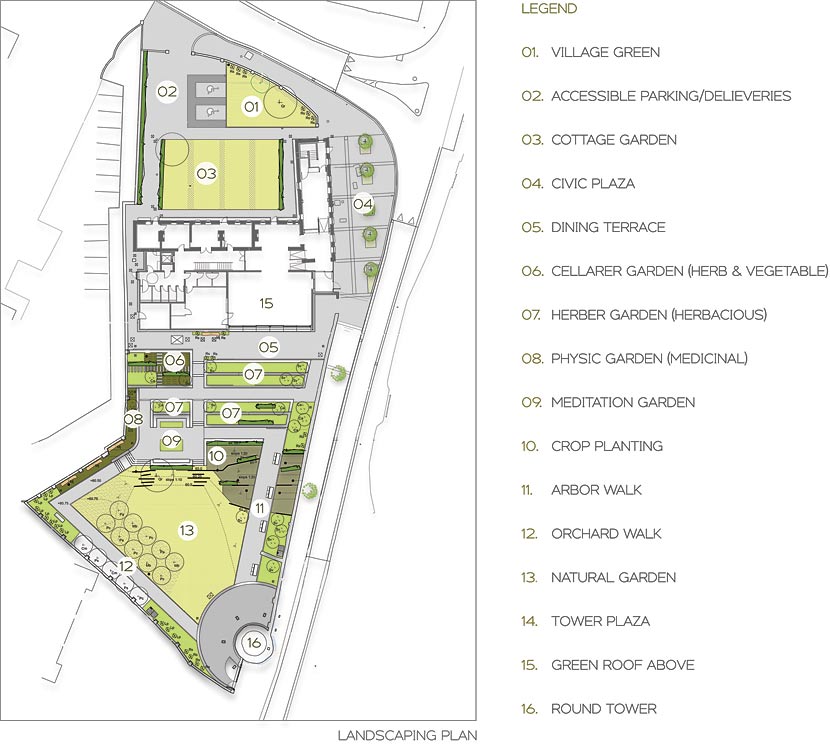Round Tower Landscaping and Garden
The Round Tower’s landscaping and planting at the Visitor Centre is inspired by the cultural and historical significance of the site. It alludes to the past in terms of its narrative and planting, while also serving a functional purpose in the life of modern-day Clondalkin.
The cottage garden at Millview Terrace on the north side of the centre is enclosed by low box hedges similar to those that would have bounded the 18th century cottages. Theses hedges would often have been used for drying and bleaching clothes on sunny days. The alignment of the original garden boundaries is delineated by lines of planted bulbs
The garden facing south towards the Round Tower echoes the medieval monastic garden that would have tended to the spiritual, medicinal and culinary needs of those living within the ancient boundary of Clondalkin.
The Herber Garden is arranged in terraces along ramp which slopes gently upwards towards the natural/wild garden adjacent to the tower. The Herber Garden in monastic life was made up of herbaceous borders. This garden has echoes of the ‘Paradise Garden’ or the ‘Hortus Conclusus’ and was dedicated to the glory and worship of God. The flowers provided decoration for holy places. Here are located the plants typical of the time that provided colour, scent and beauty to the mediaeval garden. Being adjacent to the meditation garden is appropriate, as the beauty of creation and the sounds and scents of nature can be appreciated. Plants that were associated with the symbolism of God or the saints were common. Among the plants located here are Bellflower, Christmas rose, Flax, Fennell, Foxglove, Lavender, Madonna Lily, Purple loosestrife, Rose campion, Sweet woodruff, Thrift, White Lupin, Woodspurge,
The Cellarar Garden is adjacent to the Herber Garden and the dining terrace. This garden would have provided culinary herbs and vegetables to the monastery kitchen. It is functional and served an important role in Monastic life allowing it to be self-sufficient. Amon the typical plants located here are Typical plants include Basil, Bay, Broad Bean, Beet, Borage, Chives, Cabbage, Carrots, Carnation, Dandelion, Dill, Fennel, Leek, Lettuce, Marigold, Marjoram, Mint, Onions, Parsley, Parsnip, Pea, Radish, Red Dead Nettle, Rocket, Rosemary, Spinach, Thyme, Valerian, Sorrel, Turnips, Wild Garlic
The Arbor Walk reflects the ‘Cloister’ of the Monastery. It runs alongside the existing 18th century wall to Tower Road, passes through crop planting areas which contain oat wheat and barley and is also framed by multi-stem tree clusters of Willow and Hazel. These trees would have been harvested by the monks for fencing and firewood and other purposes using a technique called coppicing which allows new wood to efficiently regenerate from the base of the tree. The cloister provided shelter, seclusion and shade in the garden and enabled one to meditate without being over-looked
The Orchard Garden continues the cloister theme along the southern boundary of the site, leading on from the Arbor Walk. The orchard also served as an ancient space for contemplation. This garden also reflects the memory of Henry VIII’s orchard. Orchards were extremely common in monastic gardens and provided burial places for monks. There one could contemplate life in the midst of death and reflect on the link with nature’s cycle of birth, death and re-birth (or resurrection). The trees were generally laid out on a grid that facilitated maintenance and allowed burials in the spaces between. The Orchard Garden contains various ornamental and fruit varieties (mulberry, hawthorn, apple, plum, and pear) typical of the time
The Natural Garden acts as a buffer to the formality of the lower terrace and provides a calm restrained setting for the Round Tower. Bounded by the various elements of the medieval monastic garden it is intended to reflect the interdependence between all of the related parts and to symbolize unity with nature at the heart of this historic site.
The Physic Garden, leads back along a circular route towards the dining terrace. This garden would have provided medicinal plants for the monasteries. It also speaks to the presence of the adjacent fever hospital marked on old maps of the area and the old dispensary which was located on Tower Road. It is located at a slight remove from the rest of the garden, as dangerous or poisonous plants may well have been cultivated here in the past and the prevention of cross-contamination with edible plants would have been essential. Typical species would have included Betony, Bugle, Chamomile, Catmint, Chervil, Chenopodium, Chicory, Comfrey, Cowslip, Lady’s bedstraw, Lady’s mantle, Lavender, Lemon balm, Feverfew, Herb Robert, Marigolds, Penny Royal, Sow Thistle, St. John’s Wort, Plantains, Wild Sage, Wormwood, Yarrow.
The Meditation Garden is a simple contemplative space central to the cascading terraces. It makes reference to the central court of the medieval monastery. The scented lawn is planted with Chamomile and Thyme. The green colour symbolises life, re-birth and eternal life. This is a quiet space located off the main thoroughfare. Daisies would have been allowed to thrive in the turf in this space as they symbolised innocence.








